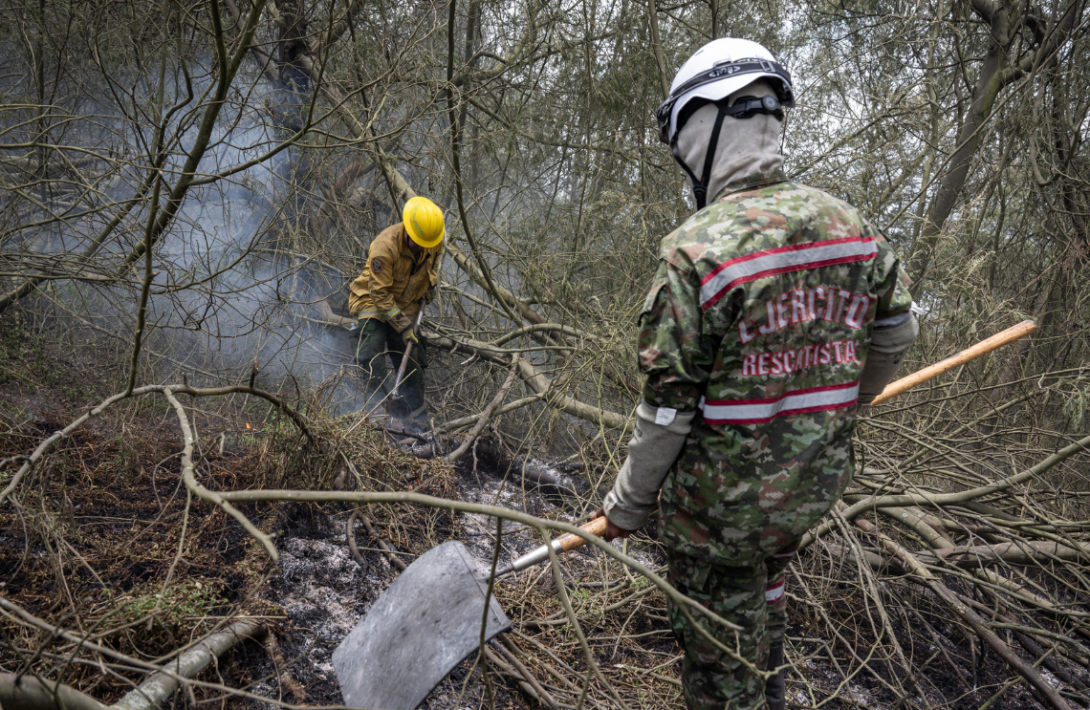- The timely operation and efficient use of resources led to contain the spread of fire and reduce damage to the ecosystem in the Province of La Sabana to the west of Cundinamarca.
- The soldiers of the Engineer Brigade of Assistance and Prevention of Disasters are trained for search and rescue, forest fires and NBQR operations (Nuclear, Biological, Chemical and Radioactive, used in the Covid 19 emergency).
- The Colombian Air Force water dropped more than 20 thousand gallons of water and chemical retardant, through the collection and water drop system in two UH60 helicopters equipped with the bambi bucket system.
With aerial reconnaissance drones and hand tools such as a rake to make defense lines and separation of combustible material, back pumps to make cooling points, brush fire brooms to quell fires, and even machetes, the soldiers of the Engineer Brigade of Assistance and Prevention of Disasters work throughout the country to neutralize and extinguish forest fires in the hardest-hit regions.
Colombian National Army and the Colombian Air Force, as part of the National Disaster Risk Management System, contribute with all their technical resources and trained personnel to support the Civil Defense, official and volunteer Firefighters, local municipalities and municipal institutions to find hot spots and prevent their spread.
This is how, after three days of intense work, these organizations intervened in the extinction of the forest fire in the village of Barro Blanco, in Bojacá, Cundinamarca, where more than 250 hectares were controlled thanks to the participation of specialized personnel and the use of technical equipment.
Captain Gabriel Arias, commander of the Amperio group, of the Brigade of Engineers of Assistance and Prevention of Disasters, said that the work is carried out “jointly, in order to extinguish the forest fire that hits the inhabitants, through cooling techniques with hand tools and water drops of the Colombian Air Force, to prevent that by the force of the breeze that occurs in the high areas continue to damage the fauna and flora of the area."
"Given the forest fire emergency, the first response is the local municipal teams, who determine with their resources the mitigation or extinction, then the departmental order, and finally, when the response resources exceed the greatest conflagration, it is the military engineers who support in coordination with the risk management units the control of the fire,” explained Captain Arias.
Among flames, ashes, sweat, fatigue and winds, in the upper part of the fire in Bojacá, was Corporal Johan Fernández, commander of the rescue team of the Engineer Brigade of Assistance and Prevention of Disasters No. 80, who with the hand tools contributed in the difficult work.
“The forest fire intervention team is made up of the commander, who guides and orients the rest of the team, and is in charge of security, there is in the same way a staff that is in charge of the rakes, which tools to make separate, and brush fire brooms, which are to do the extinction, in addition to the machetes and other tools, which are to cut and open space,” Corporal Fernandez reported.
One of the differential resources with which Colombian National Army carries out this mission is the reconnaissance drone, which for the fire in Bojacá, was operated by Soldier Nicolás Sierra, a member of the Battalion, with which he searches and finds the hot spots and sends the coordinates so that the rest of the team reaches the exact point.
Among its characteristics, Soldier Sierra explained, are that “it is a thermal drone, it has a dual camera, with a maximum linear capacity of approximately 8 kilometers, but may vary according to the terrain, there are broken, high, or low, it in the same way depends on the high or low temperatures. It is thermal, which leads to search and find the heat sources, which takes an evidence of it in the smart controller (remote control with which the operator flies the drone)”.
Given the successful containment of the forest fire, the mayor of Bojacá, Gabriel González, presented the fire control report obtained since last Wednesday, September 18, for which he thanked the relief agencies for “exposing their lives and doing a hard job.”
Currently in Colombia, according to the report of the National Risk and Disaster Management Unit, this Sunday, there are 35 forest fires, of which 29 are active and 6 controlled.
Source: Colombian National Army





